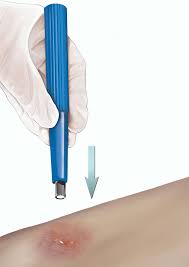
A biopsy is a medical procedure in which a small sample of tissue is taken from a suspicious or abnormal area on the foot for further examination under a microscope. This procedure can help diagnose the cause of the lesion, such as infection, inflammation, or cancer.
The biopsy can be performed using various methods, depending on the size and location of the lesion. Some common techniques include:
- Punch biopsy: A small, circular instrument is used to remove a cylindrical sample of skin and tissue from the lesion.
- Incisional biopsy: A surgical knife is used to remove a small wedge-shaped section of the lesion.
- Excisional biopsy: The entire lesion is removed, along with some surrounding healthy tissue.
- Needle biopsy: A thin needle is inserted into the lesion to remove a small sample of cells.
The type of biopsy performed will depend on the location and size of the lesion, as well as the suspected diagnosis. In some cases, the biopsy may be performed under local anaesthesia to minimise discomfort.
After the biopsy, the sample is sent to a laboratory for analysis. The results of the biopsy can help guide further treatment and management of the foot lesion. Your doctor will discuss the results of the biopsy with you and recommend appropriate next steps based on the diagnosis.
